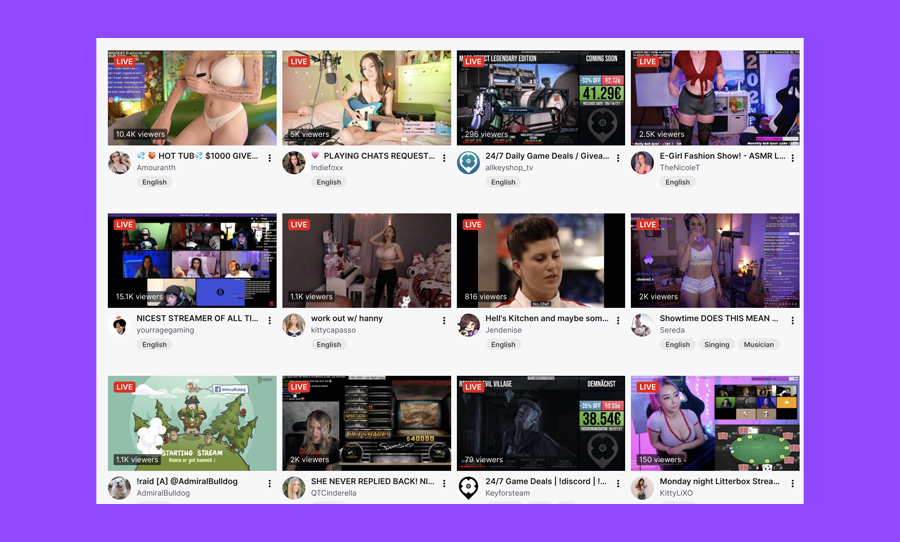Building tensions surrounding Twitch’s hot tub meta highlight a deeply ingrained misogynistic narrative that permeates the platform.
Since early April 2021, the Twitch community has become divided over a recent trend dubbed the ‘hot tub meta’. As its name would suggest, the trend features streamers wearing their swimwear in a hot tub whilst chatting to their audience. Some streamers opt for a cheaper alternative, such as a blow-up swimming pool.
Others skip the pool altogether and use a green screen to simulate the hot tub. Streamers within this category are usually female, however, some male streamers have jumped on the bandwagon. Many do so earnestly, and others represent a caricature of the female streamers who are dominating the medium.

Hot tub meta 101
To understand why this is becoming such a hot button issue, it’s important to understand how we’ve arrived at this point. Twitch was originally started in 2011 as a video game live streaming service, and since then the platform has exploded in popularity, creating many different categories of streaming.
There’s fishing, woodworking, cooking, and even studying. The majority of content on the platform still centres around gaming, however, Twitch has expanded and made space for much more than that. A majority of viewers are also males between the ages of 16 and 24 years old.
This is also not the first time women on Twitch have come under fire for what they wear. For a long time, there was a cohort of female streamers branded ‘titty streamers’ because they showed what the community deemed too much cleavage on stream. After much hounding by the community, Twitch introduced a revised terms of service to reduce the amount of ‘titty streamers’ on the platform.
Here’s a link to the ruleset, but to put it succinctly streamers cannot present themselves in a sexual manner within the context of the stream. For example, Twitch won’t allow you to wear lingerie and perform pole dancing as they deem the context of the situation innately sexual. Twitch will allow you to broadcast yourself wearing swimwear if you are in a context that requires it, such as being at the pool or in a hot tub, and that’s because the situation is not overtly sexual.
Now an important distinction needs to be made here, and it was best illustrated by streamer xoAeriel during a Kotaku interview.
“You can be sexy without being sexual,” she said, “and I think that’s where a lot of people have hot tub streams confused. Are bikinis sexy? Yes. But are they sexual? No. Same with low-cut shirts. We are allowed to have unlimited cleavage. Is cleavage sexy? Yes. But is it sexual? No.”
https://twitter.com/Froskurinn/status/1388157522377383941
The majority of the criticism towards hot tub streamers fail to understand that the female body is not inherently sexual. In journalist Brooke Meredith’s excellent article outlining this distinction, she writes:
“As a society, we have made and continue doing so, women’s bodies ever sexual things. Further, we do this, in large part, for the pleasure of men, as well as, for the continued control and oppression of women.”
The majority of arguments against the hot tub meta comes from a place that views a woman’s sexualised body as a marker of illegitimacy to the platform. Many of the people who are vocal about their critiques believe that it’s an ‘easy’ way to gain views, rather than doing it the good old fashioned way: sitting in a chair and playing games.
https://twitter.com/wildkait/status/1389144365810032644
Researchers Ruberg, Culleen, and Brewster took on these issues and published a paper in 2019 that explored the gaming community’s disdain towards these streamers. They found that this discrimination “plays out on the level of the literal gendered body. The current rhetoric that surrounds terms like “titty streamer” attempts to deny women streamers their right to present their bodies as they choose without being subject to insult or interrogation.”
“The very fact of inhabiting bodies with breasts opens streamers to potential harassment and devalue women’s work.”
Another point the researchers address is the common misconception that women who engage in the hot tub meta are deemed as lazy, based on the misbelief that any woman could jump on Twitch in revealing clothing and instantly attract thousands of viewers.
This couldn’t be further from the truth, and “women streamers are actually expected to put more time and labour into their streams than men.”
“Far from making streaming easier, streaming in a body that reads as female to viewers makes streaming harder, more labour-intensive, and more difficult socially.”
However, some streamers still don’t feel this way.
IM GONNA BE HONNEST, THIS HOT TUB META IS BY FAR THE MOST PATHETIC THING WE'VE SEEN ON TWITCH IN FOREVER. WHAT A SAD REALITY. PLEASE GET THIS TRASH OFF THE FRONTPAGE
— xQc (@xQc) April 19, 2021
Twitch and double standards
A major component of these issues is how Twitch does not communicate effectively with their own community as to what is acceptable or not. There are constant double standards that lead people into a state of confusion, this does not excuse certain responses from members of the community.
However, if Twitch were to communicate more clearly and educate their audience as to something was allowed or not allowed, it would contribute to a more progressive space.
In 2019, streamer Fareeha was banned for showing too much midriff during a workout stream. Obviously, on a platform where the hot tub meta can reside safely with the terms of service, this would be deemed a double standard. Unfortunately, this is not an isolated incident.
Because workout clothes and showing midriff=lingerie ok ok ok cool cool cool pic.twitter.com/KNSCinmMIP
— Fareeha 🍉 (@AskFareeha) September 14, 2019
Streamer Quqco also fell victim to a double standard ban when she did a Just Chatting stream dressed as a character from the popular beat-em-up franchise Street Fighter.
I just got banned again for wearing a Chun Li cosplay. I am fully covered. I don’t understand @TwitchSupport @twitch how is this sexually suggestive content? pic.twitter.com/qP1WoBbZL3
— quqco (@quqco) September 15, 2019
The controversy surrounding the hot tub meta is a two-part issue. Firstly, a large portion of the male-dominated community is unable to view a women’s body in a non-sexualised manner. They see it fit to comment on what women are wearing on the platform even though it falls in line with the terms of service laid out by Twitch.
Secondly, Twitch’s inability to address and educate their community as to why they allow it on their platform contributes to the discriminatory narrative that is rife within its walls. This is also perpetuated by the double standard bans as highlighted above.
If Twitch truly wants a progressive community, they need to be better at communicating with their wider audience and educating them when these issues arise, rather than letting tensions boil and simmer for months on end.



